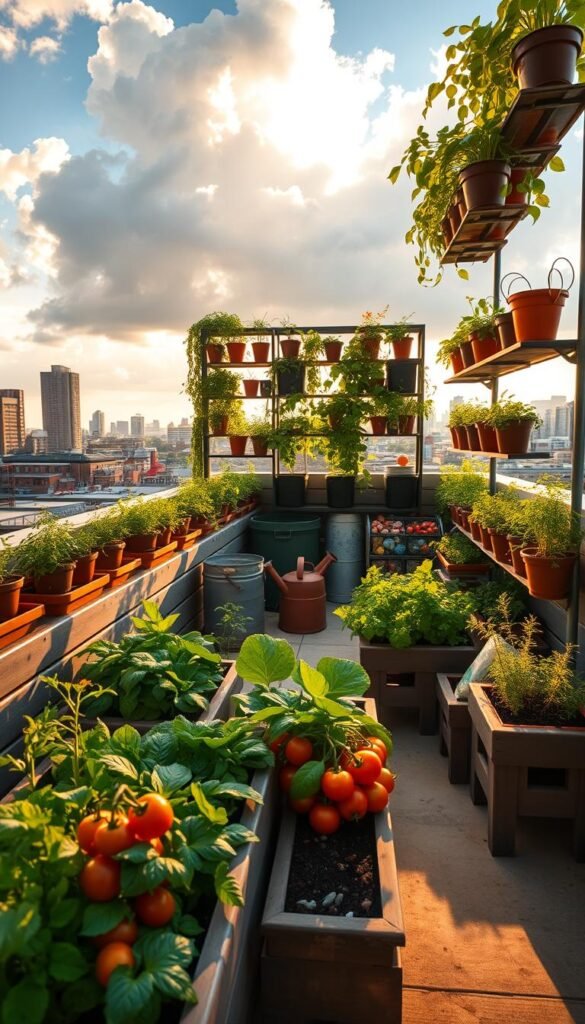What if your apartment balcony could become a thriving source of fresh produce? Across America’s metropolitan areas, residents are proving that concrete landscapes can bloom with life. This movement isn’t just about plants—it’s reshaping how we interact with our surroundings, turning overlooked corners into vibrant ecosystems.
The secret lies in resourceful design and smart space management. Vertical planters transform blank walls into lettuce factories, while compact hydroponic systems fit neatly under kitchen windows. Even fire escapes get new purpose as herb nurseries, demonstrating how every inch counts when rethinking urban environments.
Why are so many people embracing this approach? Beyond the obvious perks of homegrown tomatoes, there’s a deeper craving for meaningful connections. Tending living things offers respite from screen-dominated routines, blending productivity with mindfulness. Studies show these green oases reduce stress while fostering neighborhood bonds through shared harvests.
You don’t need sprawling yards to start cultivating. Modern techniques make it possible to grow robust crops in shoebox-sized containers. The key is matching plant varieties to your specific conditions—whether that’s a sun-drenched terrace or a partly shaded stairwell. With the right strategies, even first-time growers can enjoy salad greens within weeks.
This guide will show you how to maximize limited square footage through clever layouts and low-maintenance crops. Discover how to turn perceived limitations into advantages, creating edible landscapes that nourish both body and community.
Introduction to Urban Gardening and Its Benefits
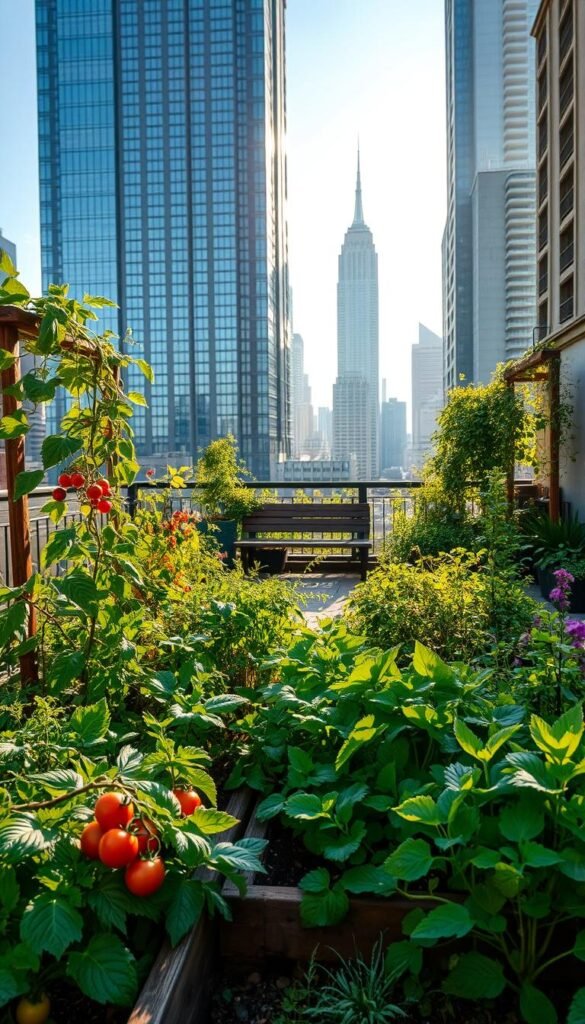
Balcony railings aren’t just for views—they’re becoming vertical farms for fresh greens. Tending plants in cramped spaces does more than beautify your home. Studies show 30 minutes of gardening lowers cortisol levels as effectively as yoga, blending exercise with mental rejuvenation. Your tiny green corner becomes a sanctuary from bustling streets.
Leafy companions double as air purifiers. A cluster of peace lilies removes formaldehyde from apartments, while herbs like basil trap dust particles. You’ll harvest cleaner air alongside pesto ingredients, creating healthier living conditions one planter at a time.
| Benefit | Apartment Gardens | Community Plots |
|---|---|---|
| Produce Yield | 8-10 lbs/month | 50+ lbs/season |
| Social Bonds | Neighbor swaps | Shared workshops |
| Temperature Drop | 2-3°F | 5-8°F |
Shared harvest festivals turn strangers into friends. Rooftop tomatoes become conversation starters, while seedling exchanges spark mentorship between generations. Even fire escape gardens support life—bees visit blooming strawberries, and ladybugs patrol for aphids.
Your container garden teaches practical science. Kids measure plant growth instead of screen time, while composting demos turn food scraps into black gold. These green pockets also combat urban heat islands—a 10x10ft garden cools as effectively as two window AC units.
Understanding Your Urban Environment
Sunlight patterns in cities aren’t random—they’re puzzles waiting to be solved. Before planting, become a detective with your space. Track how shadows move across your balcony or windowsill using free apps like Sun Seeker. You’ll discover sweet spots where kale thrives and corners perfect for shade-loving mint.
Assessing Available Space and Sunlight
Tall buildings create light challenges, but smart gardeners adapt. Try this trick: place mirrors strategically to bounce light onto parsley or spinach. For areas getting less than 4 hours of sun, consider low-light champions like Swiss chard or arugula. Rotate pots weekly so all plants get their fair share of rays.
“The best urban gardens work with existing conditions, not against them. A north-facing wall becomes a cool haven for lettuce, while reflective surfaces amplify limited light.”
Identifying Local Climate and Conditions
Your building’s materials shape microclimates more than you’d think. Brick walls radiate heat at night, creating perfect tomato-growing zones. Check this table to match plants to your unique setup:
| Factor | Impact | Solutions |
|---|---|---|
| Paved Surfaces | Increased heat | Use heat-tolerant herbs |
| Wind Tunnels | Dries soil faster | Install mesh windbreaks |
| Shaded Corners | Cool & damp | Grow mushrooms or mint |
Don’t forget seasonal shifts—what works in July might fail by October. Start a gardening journal using your phone’s weather app data. For more tips on transforming concrete spaces, track how rainfall and temperature changes affect your plants’ performance.
Planning and Designing Your City Garden Layout
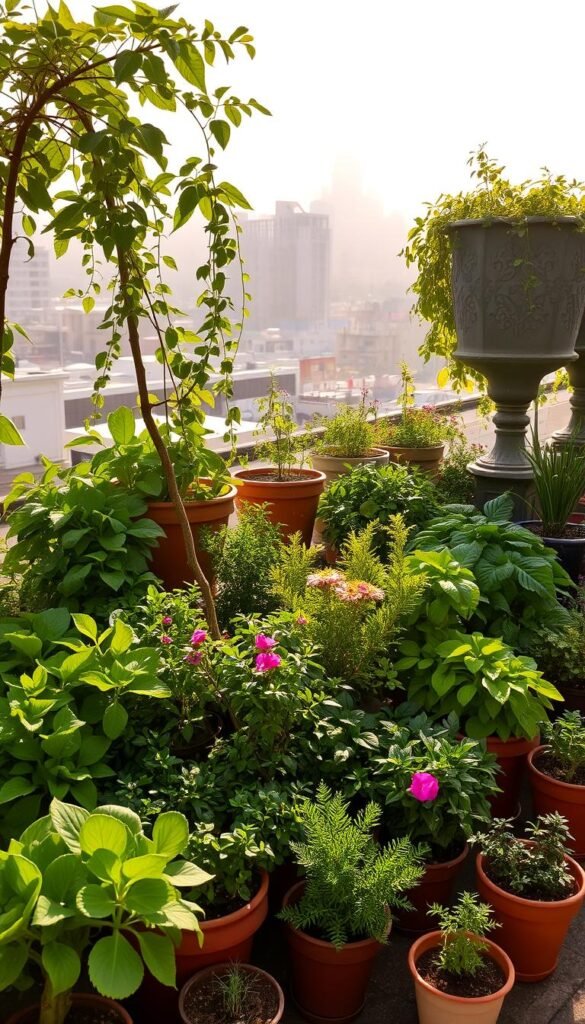
Your concrete jungle can burst with fresh flavors using smart spatial strategies. The right setup turns cramped corners into productive plots, blending beauty with functionality. Let’s explore how to craft layouts that work harder than your average backyard.
Choosing the Right Containers and Beds
Start by matching vessels to your crops’ needs. Deep pots (18+ inches) give carrots and radishes room to stretch, while shallow window boxes host spinach perfectly. Fabric grow bags offer breathability for herbs, and recycled buckets become tomato towers with drainage holes.
Raised beds solve two problems at once: poor soil and sore knees. Build them waist-high for easy access, using cedar or composite wood. Pair with hanging planters above to triple your growing area without sacrificing floor space.
| Feature | Containers | Raised Beds |
|---|---|---|
| Mobility | High | Low |
| Soil Control | Full | Partial |
| Best For | Annuals | Perennials |
Mapping Out Your Garden Zones
Divide your area into activity hubs. Keep thirsty plants near water sources, and position tall crops where they won’t shade others. Use vertical trellises as natural room dividers—pole beans create living walls that hide compost bins.
Leave 18-inch pathways between beds for comfortable kneeling. Mark zones with colored stones or mini fences—this visual coding helps track crop rotations. Remember: good design lets you harvest basil while brewing morning coffee without tripping over zucchini vines.
Soil Preparation and Amendments for Urban Gardens
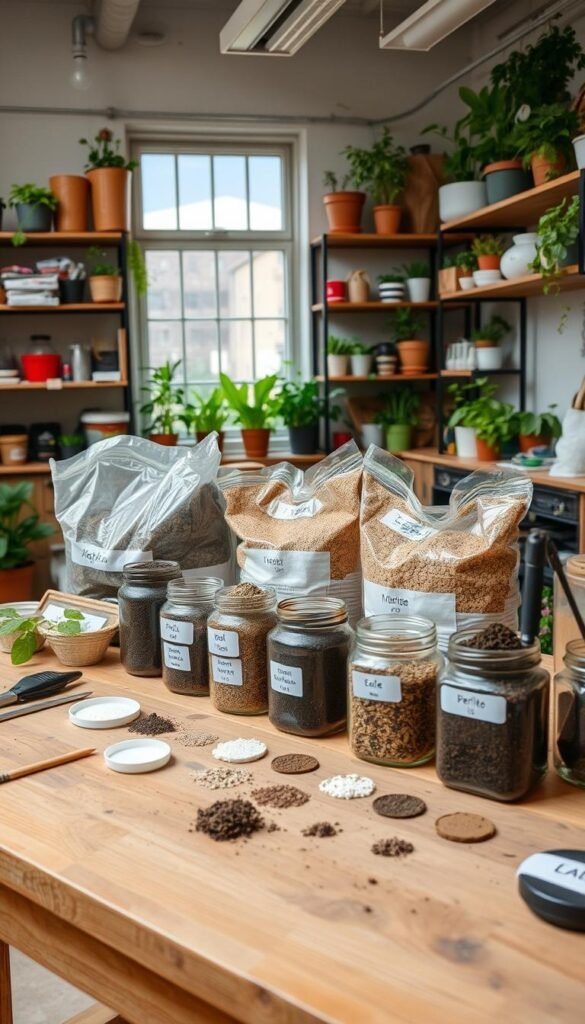
Healthy soil breathes life into your green oasis, but city environments demand extra care. Before planting, test your dirt for contaminants like lead or chemicals using DIY kits or local extension services. If results show issues, don’t worry—raised beds and container gardening let you start fresh while avoiding risky ground soil.
Testing and Improving Soil Quality
Begin with a simple jar test: layer soil and water, then check separation after 24 hours. Sandy layers drain too fast, while heavy clay stays soggy. Balance textures by mixing in compost for fluffiness and vermiculite for moisture control. For nutrient boosts, aged manure works better than synthetic fertilizers—it feeds microbes that help plants thrive.
“Think of soil as a living pantry—it needs restocking. Annual additions of organic matter keep it fertile without chemical dependency.”
Utilizing Raised Beds and Container Gardening
Build raised beds with untreated cedar boards (8-12″ deep) for root space. Fill them with equal parts topsoil, compost, and perlite—this trio prevents compaction while retaining nutrients. For best vegetables for compact setups, use fabric pots that air-prune roots naturally. Refresh beds each season with worm castings or leaf mold to maintain vibrant growth.
| Solution | Benefits | Best For |
|---|---|---|
| Raised Beds | Warmer soil, fewer weeds | Root crops & tomatoes |
| Containers | Portability, pest control | Herbs & leafy greens |
Remember: Healthy soil means happier harvests. Test regularly, amend thoughtfully, and watch your edible haven flourish.
Urban Gardening Hacks: Growing Veggies in Tight City Spaces
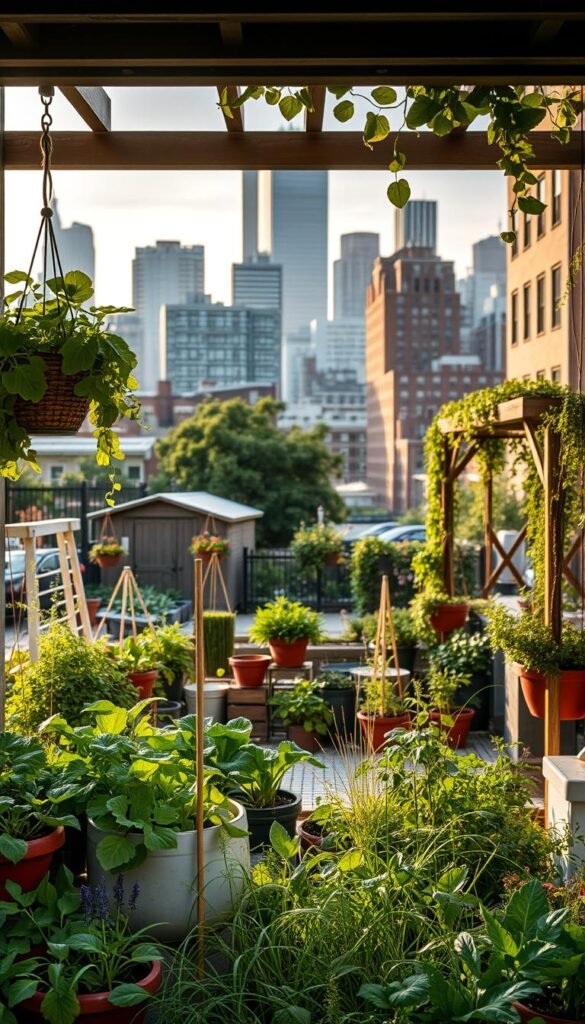
Ever thought your fire escape could double as a salad bar? With little creativity, overlooked nooks become thriving edible zones. The trick lies in seeing potential where others see limitations—that rusty ladder? A future cucumber trellis.
Creative Solutions for Limited Areas
Start by claiming every available inch. Hang shoe organizers on balcony rails for strawberry pockets. Turn wooden crates into mobile herb towers that chase sunlight. Even drainpipes get new life as vertical planters for leafy greens.
Try these space-maximizing tips:
- Place containers 18″ from walls to create depth illusions
- Stack pallet planters against brick surfaces for instant green walls
- Use wheeled carts under outdoor stairs for movable mint gardens
“True innovation happens when constraints spark imagination. That ‘useless’ alley corner? Perfect for dwarf tomatoes.”
| Space | Solution | Best Plants |
|---|---|---|
| Window ledges | Magnetic planters | Basil, thyme |
| AC drip zones | Self-watering pots | Kale, chard |
| Bike racks | Hanging baskets | Peas, nasturtiums |
Layer tall sunflowers with pole beans below—they’ll climb naturally. Paint tin cans bright colors to define spaces while growing radishes. Remember: urban gardening thrives on reinvention, not perfection.
Maximizing Yields with Vertical Gardening and Succession Planting
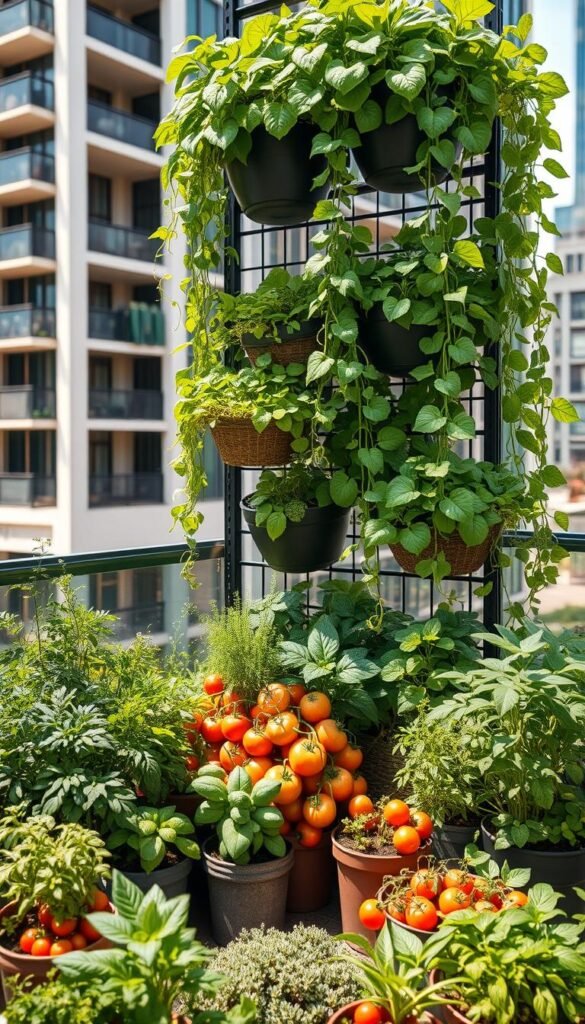
Skyscrapers taught us to build upward—now your garden can too. By stacking plants instead of spreading them, you’ll unlock 3x more harvests without expanding your footprint. This approach works whether you’re working with a fire escape or a studio apartment window.
Vertical Gardening Essentials
Start with strategic supports that match your plants’ needs. Cucumbers thrive on A-frame trellises, while cherry tomatoes prefer spiral stakes. For herbs and strawberries, try pocketed fabric panels that turn walls into edible tapestries.
Consider these space-saving systems:
| Method | Space Used | Best Plants |
|---|---|---|
| Tower planters | 2 sq ft | Leafy greens, herbs |
| Hanging gutter gardens | Vertical airspace | Strawberries, peas |
| Modular wall units | Wall surface | Succulents, microgreens |
“Vertical systems need 30% more frequent watering—but yield 60% more produce per square foot than traditional pots.”
Intercropping and Succession Strategies
Pair quick growers with slowpokes for constant harvests. Sow radishes between broccoli plants—they’ll mature before the brassicas need room. When lettuce bolts, replace it with heat-loving okra that thrives in summer sun.
Try this rotation schedule:
- Spring: Peas → Summer: Peppers → Fall: Kale
- Early tomatoes → Late bush beans
Compact varieties like ‘Patio Princess’ eggplants keep your vertical setup manageable. Feed plants weekly with liquid seaweed to maintain nutrients in tight root zones.
Essential Tools and Techniques for Every Urban Gardener
The right tools transform cramped corners into productive gardens. Space-smart solutions let you cultivate fresh flavors without clutter, blending functionality with clever storage. Let’s explore gear that fits your lifestyle while boosting plant health.
Selecting Compact Gardening Tools
Choose multi-taskers that disappear when not in use. A foldable hand trowel tucks into drawer gaps, while telescopic pruners adjust for tall vines. Look for these essentials:
- Collapsible watering cans with 180° spouts
- Pocket-sized soil test kits
- Magnetic tool strips for vertical storage
Fabric grow bags outperform rigid pots—they fold flat post-season and prevent root circling. Pair them with wheeled plant caddies to chase sunlight across balconies. For herbs, try stackable planters that double as privacy screens.
Efficient Watering and Maintenance Methods
Smart hydration systems prevent overflows in tight spaces. Self-watering containers with wicking reservoirs cut daily chores by 60%. Try this comparison:
| Method | Water Savings | Best For |
|---|---|---|
| Drip irrigation | 40% | Tomatoes, peppers |
| Watering globes | 30% | Potted herbs |
| Ollas (clay pots) | 50% | Leafy greens |
“Urban growers succeed when tools serve multiple purposes. That repurposed shoe organizer? It’s both strawberry planter and vertical garden art.”
Maintain momentum with weekly checkups. Use a toothbrush for pest patrols and old chopsticks as mini stakes. Store supplies in hanging baskets beneath shelves—easy access, zero floor space.
Overcoming Common Challenges in Urban Gardening
Your tiny green haven might face some unexpected guests—aphids throwing parties on your kale. Don’t panic. With smart strategies, you’ll keep your plants thriving despite tight spaces and tricky conditions.
Managing Pest and Disease Issues
Start with prevention. Wipe leaves weekly to disrupt spider mite hideouts. For infestations, mix 1 tsp neem oil with water—it stops 90% of soft-bodied pests without chemicals. Sticky yellow traps catch flying nuisances before they lay eggs.
Invite natural allies. Ladybugs devour 50 aphids daily, while lacewing larvae tackle thrips. If diseases strike, remove affected leaves immediately and improve airflow. Rotate crops yearly to break pest cycles.
Dealing With Limited Sunlight and Water
No south-facing windows? Use mirrors to bounce light onto herbs. Reflective mulches boost brightness by 20%. For water efficiency, try self-watering pots or repurpose old wine bottles as drip feeders.
Group plants by thirst levels. Basil and tomatoes love frequent sips, while rosemary prefers dry spells. If troubleshooting hydroponic systems, check pH weekly—most greens thrive at 5.5-6.5.
Remember: Every challenge has a green solution. Adapt, experiment, and watch your gardens flourish against the odds.

